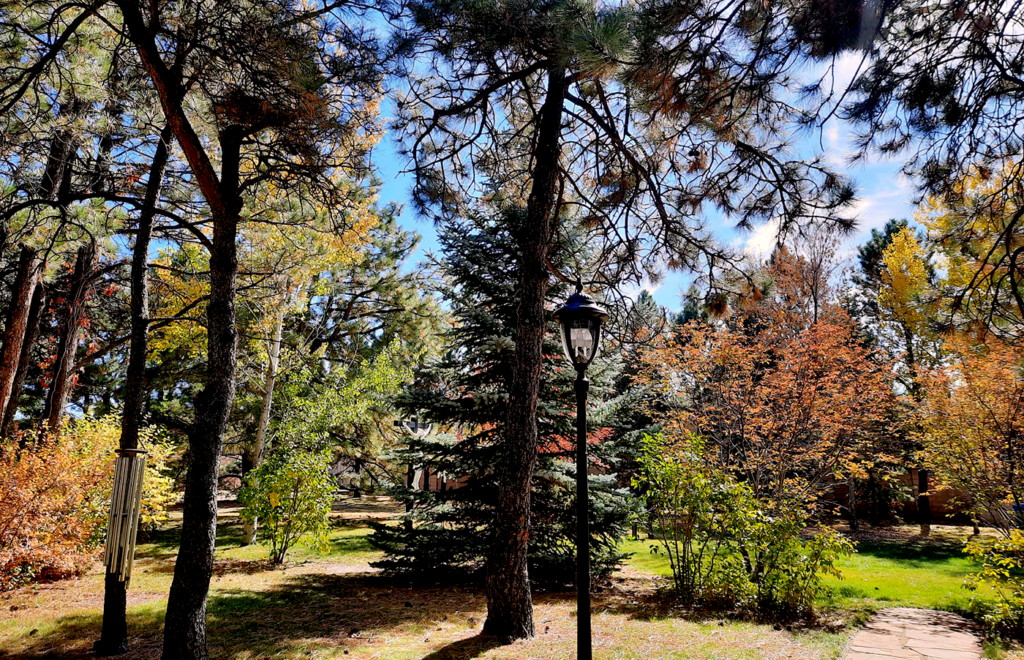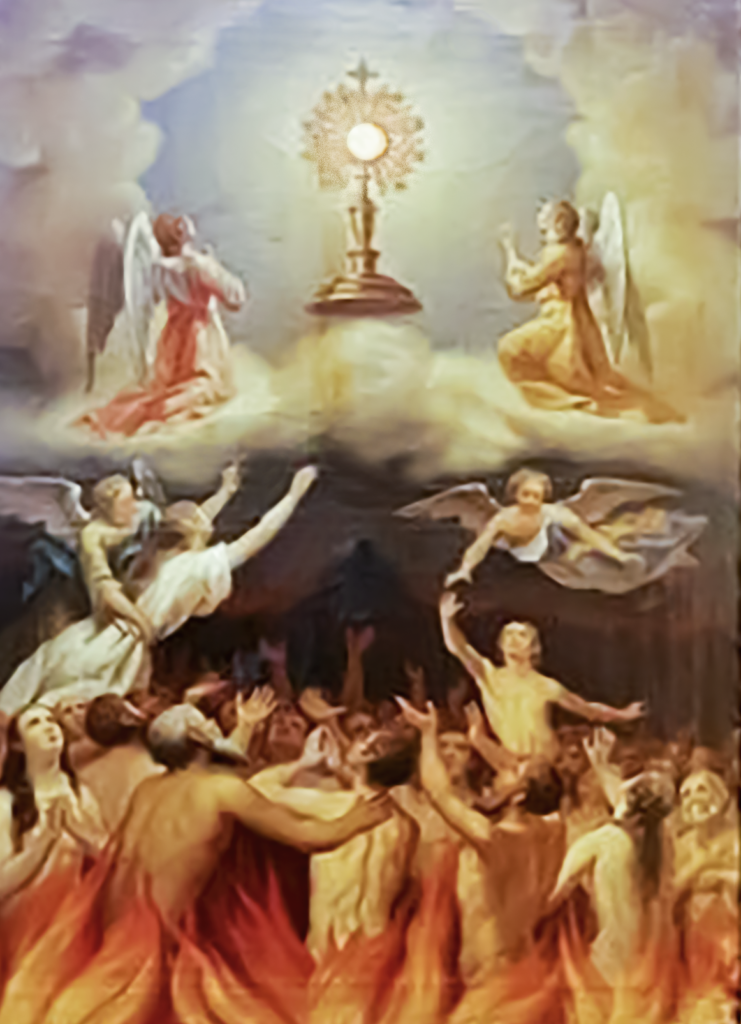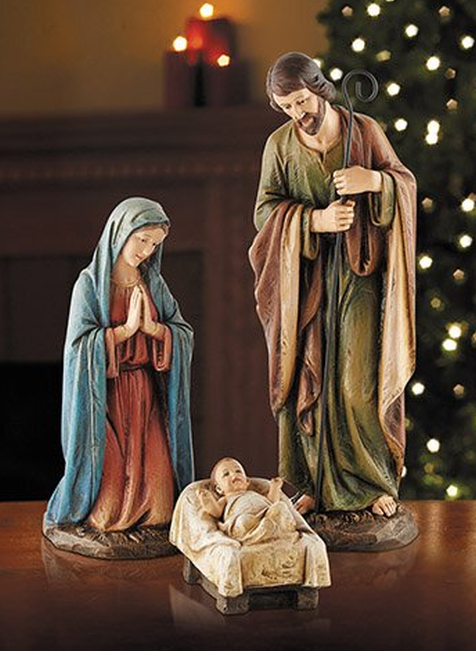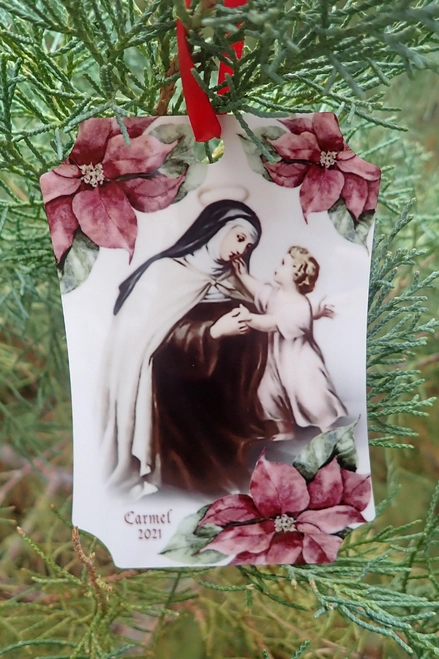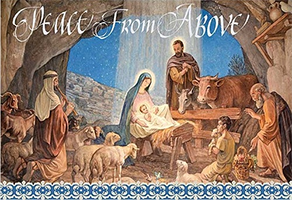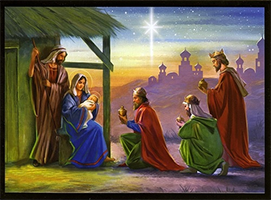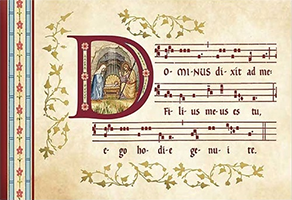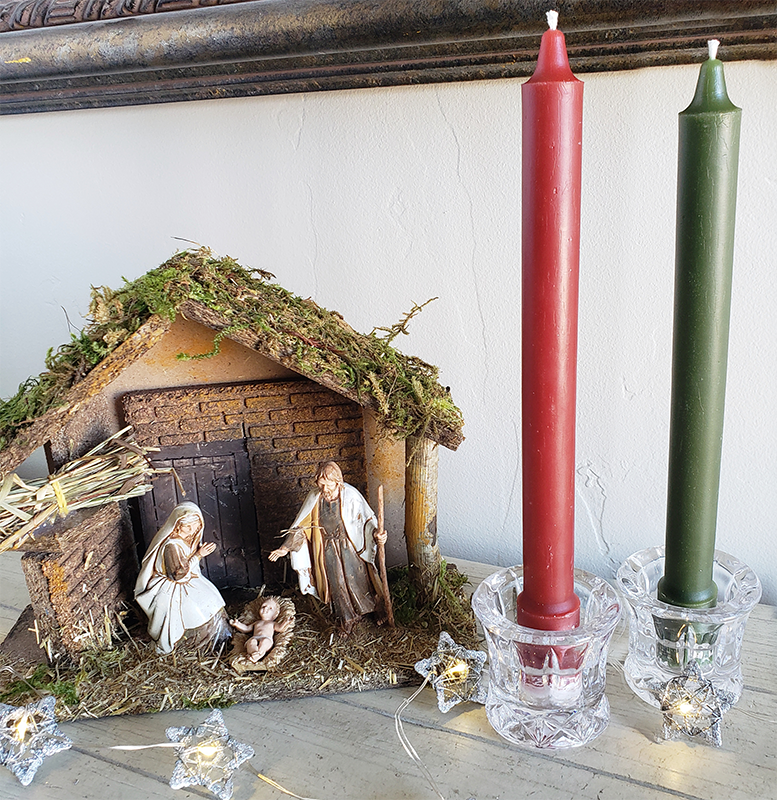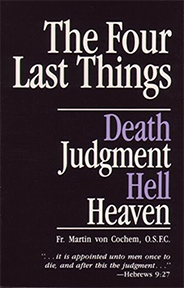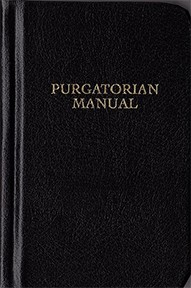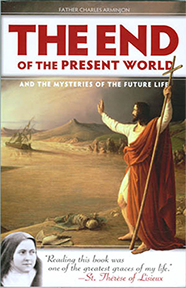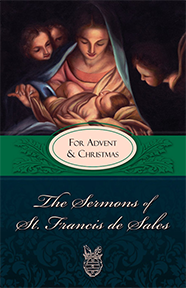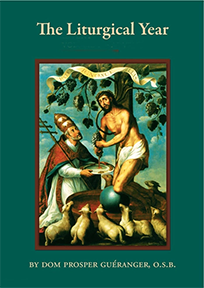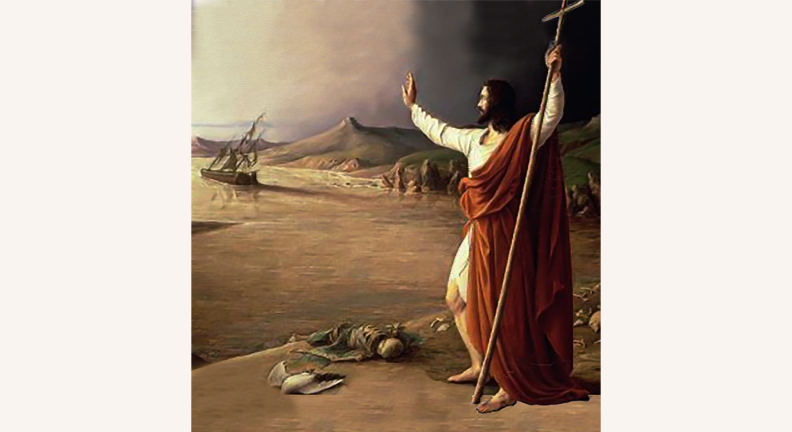
Look Up, Lift Up Your Head
The just shall stand with great assurance before their oppressors who set at nought their labors. Seeing this, these shall be shaken with dreadful fear, and amazed at the suddenness of the unlooked-for salvation. They shall say among themselves, rueful and groaning through anguish of spirit: “These are they whom once we held as a laughingstock and as a type of mockery, fools that we were! Their life we deemed madness, and their death dishonored. See how they are accounted among the sons of God; how their lot is with the Saints!”
– Wis. 5, 1-5, from the Mass of the Martyrs
Dear Friends of Carmel,
During these past few months, we have once again watched nature “wind down.” The summer glory of the trees blazed into autumn color and now has all but faded. The Liturgical life of the Church and our own spiritual lives mirror nature and its seasons.
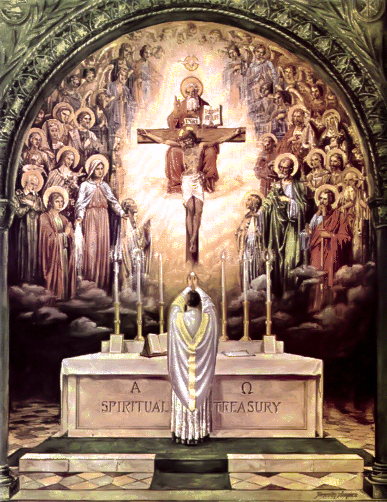
Towards the end and climax of the Liturgical Year, we come to what we sometimes call the “Triduum of the Mystical Body of Christ,” and we would like to share with you a few thoughts that were given to us through sermons and conferences on these great Feast Days.
In the traditional liturgy, the last Sunday of October is the Feast of Our Lord Jesus Christ the King. (There is much to comment on here that would be quite relevant and poignant regarding the Kingship of Christ and the reasons behind the institution of this Feast in 1925. We recommend reading the Papal Encyclical, Quas Primas, to learn more). The celebration of this Feast is an acknowledgment of His rights and prerogatives as God made Man and His true Kingship over the universe.
On November 1st, the Church rejoices to celebrate the “fruits” of that Kingship on the Feast of All Saints. We honor the Saints in heaven as the chief examples of His saving power and the wonders of His grace. From every age and background – and even from the depths of sin – these souls responded to God’s grace and allowed it to carry through every aspect of their lives. They became models of virtue and reflections of the very holiness of God. We acknowledge God’s great work in their souls, and we humbly implore them to intercede for us before God’s throne, that we may follow in their footsteps and carry the Cross, the standard of the Lord, to the end.
The following day, November 2nd, is the Commemoration of the Faithful Departed, or All Souls Day, on which the Church keeps prayerful remembrance of the suffering souls in Purgatory. These are the holy souls who died without the guilt of grave sin, but still need to expiate the just penalty for their sins and to be purified from their deep-seated faults, the offensive, harmful traits they have acquired: the “remains of sin”. All of this must be put in order before they may be admitted into the all-pure light of the beatific vision.
So, in fitting and triumphant veneration, the Head of the Mystical Body, the Church Triumphant, and the Church Suffering are acknowledged, honored, and prayed for within the space of a few short days by all of the Faithful on earth, the Church Militant.
This is the wonderful doctrine of the Communion of Saints at work, that sharing of spiritual solidarity which binds all the Faithful together in a constant interchange of supernatural “offices” or duties for the good of all. It has long been the custom that all the participants are called saints, by reason of their destination and of their partaking of the fruits of the Redemption (1 Cor 1:2).
Throughout these important Feastdays, one cannot help but turn one’s thoughts to one’s own eternal destiny. The joys of Heaven, the purifications of Purgatory….all are brought before our minds just as the Liturgical Year comes to a climax. It is the intention of Holy Mother Church that we turn our meditations towards our death and judgment, and ultimately the Last Judgement, which is both the theme of the last few Sundays of the year and the focus of the penitential season of Advent.
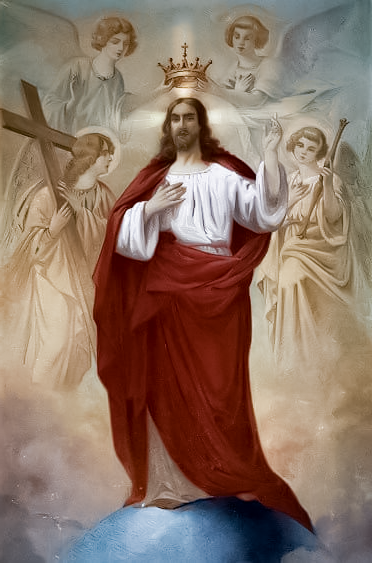
Meditating on the Last Judgement, and even our own death, has a very specific and salutary purpose in the spiritual life: it serves as both warning and consolation. Warning in that we are confronted with the reality that time – our time, all time – will cease. This work-a-day world that we get so involved in will come to an end, for us personally, and then definitively at the end of time. What better reason have we for reforming the way we spend our time than to have in frequent and even habitual remembrance that we only have so much of it? (More in our past newsletter The Shortness of Time and the Length of Eternity)
On the other hand, it is consoling in that just as time will cease, so will the sufferings and persecutions, the trials and crosses we all carry. There is a God in Heaven, Who sees all, Who measures all, Who remembers all – and the day will come when He will balance all things on the scales of His Divine justice. How much could be said about this point in our own day! We need not bring before your mind the injustices, the slanders, the persecutions that God and His children suffer in these times. “But when these things begin to come to pass, look up, and lift up your heads, because your redemption is at hand (Lk.21:28).” The reason that the end of all things and the Final Judgement are such a prominent theme in the preparatory season of Advent is that Christmas truly was the beginning of that end. Christmas was the promise of final fulfillment of the proclamation: “Peace to men of good will (Lk. 2:14).”
Father Faber (1814-1863) composed the following lines nearly two hundred years ago. But age-old is the battle that we fight – and that must be fought – until the end of time. We think it a fitting “anthem” for these our days, and we hope that you will appreciate it as much as we do:
The Right Must Win
by Father Fredrick Faber
O it is hard to work for God,
To rise and take His part
Upon this battlefield of earth,
And not sometimes lose heart!
He hides Himself so wondrously,
As though there were no God;
He is least seen when all the powers
Of ill are most abroad;
Or He deserts us at the hour
The fight is all but lost;
And seems to leave us to ourselves
Just when we need Him most.
O there is less to try our faith
In our mysterious creed,
Than in the godless look of earth
In these our hours of need.
Ill masters good; good seems to change
To ill with greatest ease;
And, worst of all, the good with good
Is at cross purposes.
The Church, the sacraments, the faith
Their uphill journey take,
Lose here what there they gain, and, if
We lean upon them, break.
It is not so, but so it looks;
And we lose courage then;
And doubts will come if God hath kept
His promises to men.
Ah! God is other than we think,
His ways are far above,
Far beyond reason’s height, and reached
Only by childlike love.
The look, the fashion of God’s ways
Love’s lifelong study are;
She can be bold, and guess, and act,
When reason would not dare.
She has a prudence of her own;
Her step is firm and free;
There is cautious science too
In her simplicity.
Workman of God! O lose not heart,
But learn what God is like,
And in the darkest battlefield
Thou shalt know where to strike.
O blest is he to whom is given
The instinct that can tell
That God is on the field, when He
Is the most invisible!
And blest is he who can divine
Where real right doth lie,
And dares to take the side that seems
Wrong to man’s blindfold eye!
O learn to scorn the praise of men!
And learn to lose with God!
For Jesus won the world through shame,
And beckons thee His road.
God’s glory is a wondrous thing,
Most strange in all its ways,
And, of all things on earth, least like
What men agree to praise.
As He can endless glory weave
From time’s misjudging shame,
In His own world He is content
To play a losing game.
Muse on His justice, downcast soul!
Muse and take better heart;
Back with thine angel to the field,
Good luck shall crown thy part!
God’s justice is a bed where we
Our anxious hearts may lay,
And, weary with ourselves, may sleep
Our discontent away
For right is right, since God is God,
And right the day must win;
To doubt would be disloyalty,
To falter were to sin!
Website News
Christmas Sacramentals
As the years have passed, we have endeavored to send our November/Advent newsletter (read more about Advent on our website or in our past newsletters) ever earlier… How we dislike colliding with the commercial “Christmas rush!” But with Black Friday, and Cyber Monday, and then Cyber week, and now “pre-Black Friday”…..it has become almost impossible to avoid falling into the “HOLIDAY advertising” category.
In fact, now the “Christmas craze” has become so intense that we have heard of people beginning to boycott it – refusing to participate in decoration contests, dreading the family gatherings, troubled at the very thought of getting gifts for everyone. How easy it is to forget – how many people even know? – that all of these customs have their roots in a deep and rich Christian heritage. Remove Christ from Christmas, as our commercial world incessantly tries to do, and all you are left with is an empty shell.
For example, the Christmas tree has its origins in the 11th century when the “Paradise Tree” was part of Christmas plays that recreated the story of Adam and Eve. This tree also represented redemption, so it was decorated not only with apples, but with wafers representing the Holy Eucharist. As time went on, these wafers were replaced with sweets and candy. “The Christmas light” (another old custom consisting of lighting candles in honor of “the Light of the world”) was eventually combined with the “Paradise Tree,” explaining the origin of modern day Christmas lights. The Christmas star or Angel that was the crowning piece of the Nativity set, was eventually moved to the top of the tree, since the Nativity set came to be placed at the foot of the tree, where children could see and be near it.
Probably quite a few people know that the Nativity Set came from St. Francis, but how many realize that the two interwoven colors of the candy cane represent Our Lord’s divinity and humanity, intertwined in the shape of a shepherd’s crook? Gifts were given on Christmas in honor of Christ’s birthday (“As long as you did it for these the least of my brethren you did it for me”) and in memory of the Magi. And while the image of “Santa Claus” has developed over the years with elements borrowed from pagan mythology, its origin, of course, is Saint Nicholas, the priest and bishop who was known secretly to provide dowries for poor girls who were at risk of resorting to prostitution in order to earn their own dowry. The good Bishop would drop bags of coins through their windows, or leave them in their shoes inside the front door.
Catholicism has never confined itself to the Church building alone. It penetrated every aspect of life and culture, even in the food people ate and the songs they sang. Several years ago, we took the time and effort to post on our website the lengthy section about Christmas from an old book called Handbook of Christian Feasts and Customs. For we consider it quite tragic that so few understand why we do the things we do at Christmastime, why an entire society celebrates with so many of the same or similar customs year upon year, and what are the fascinating and, in some cases, sublime origins of these traditions! While not essential to Faith, they enrich, and “decorate” that Faith, bringing the true meaning of Christmas into every aspect of life. In the end, these customs cannot help but deepen that Faith for those who keep and cherish them with “good will”. Of course, this is the purpose they served in days of old… and surely why in these “new order” days, they are squelched at every turn! We invite you to the pleasurable reading about the Christmas traditions – and to the happy and beneficial keeping of them with your family and friends!
In addition to our wood-carved Nativity sets, we have added a few other selections to our website this year. We have also expanded our offering of Christmas tree ornaments, including one that we designed and produced ourselves featuring the consoling words of St. Teresa’s Bookmark from our Christmas message last year. Of course – don’t forget your Christmas cards! No matter how much we stock up, we do tend to run low on many designs as Advent and Christmas draw near. So even though it is too early to send greetings of the dear season of Christmas, make sure you have your cards on hand. We might add what you already have heard: shipping and delivery are already slowing, due to all the factors you’ve seen in the news…With that in mind, we would also recommend that if you are planning on any rosaries as Christmas gifts, that you order soon!
CHRISTMAS CANDLES – We also have a new set of candles to introduce to our website – Christmas candles! These beautiful Colonial style candles come in both red and green. Aside from the dye, they are made of the same 100% beeswax as our other candles. As always, we will be happy to have them blessed for you if requested at checkout. Observe in your home that beautiful custom of “Christmas Lights” using these beautiful, lightly honey-fragrant candles.
Spiritual Reading
Earlier in our newsletter, we spoke of the end of time and eternity; of the Liturgical Year and the end of time; of our eternal destiny. These are always good things to read about and ponder, but good especially at this time of year. When all about us in nature we see those signs of dying and the end of life, and in society those signs of upheaval and unrest, taking up meditative reading on these things teaches, clarifies, explains, reassures.
It has ever been the practice of the Catholic Church to recommend to her spiritual children the meditation on man’s “four last things – death, judgment, heaven, and hell.” Fr. Martin Von Cochem’s book of the same name is the classic on this inescapable aspect of our existence – our end. Always of interest to every soul seeking its way to heaven, always pertinent.
And not forgetting that this is the month of November especially dedicated to praying for the Poor Souls, we recommend another new selection to our books on Purgatory, the Purgatorian Manual. This pocket sized prayer book contains every prayer, novena, and Mass text for the Holy Souls. It was originally printed during the second world war, and was extremely popular among American Catholics during those years.
We have recommended The End of the Present World and the Mysteries of the Future Life before – and do so yet again. Its subjects are relevant and interesting, even fascinating. The author was a priest who spent years living a worldly, superficial life in his vocation, but received from God the grace to realize his foolishness and make a conversion. Prophecy, Old and New Testament revelation, and the challenging, consoling doctrines of the Catholic Faith form the basis of Father Arminjon’s preaching – to bring souls back from a shallow existence to a daily facing of the great realities – God, sin and redemption, life and death, eternity.
The Virgin Mary and the Apostles of the Last Times has become one of the most popular books offered on our website. When we say “popular”, we mean of keenest interest. The book is a wonderful summary and simple analysis of the work of St. Louis de Montfort, that great child and disciple of Mary. The saint’s prophetic insights are drawn from Holy Scripture, particularly the Gospels and the Apocalypse. Who are the “apostles of the last times”? We are. At least we should be. St. Louis speaks of the virtues needed to be those apostles – those who prepare themselves and the world for the end of time and the definitive coming and victory of Christ. Priests, in particular, will appreciate and benefit from this book – several dramatic chapters are specifically for priests and instruct about their crucial work, in God’s Name, for souls as they face a world always journeying to its end.
The coming seasons of Advent and Christmas have their joy-filled reading, too, of course! Prophecy, fulfillment, history, charm all surround the event of Christ being born upon our earth. Archbishop Goodier’s classic, The Prince of Peace, is a book of meditations that will carry one through all of Advent and into the Christmas season. Another book that would be of Christmas/Holy Family interest is Loreto and the Holy House. The tradition is that the Holy House of Nazareth was translated by Angels from Palestine to different locations in Europe, until resting in its present location of Loreto, Italy. This miraculous work may be doubted by most, but this book goes a long way to debunking the debunkers! The early chapters tell of how numerous doubters over the centuries took it upon themselves to prove it all wrong – only to discover more evidence in favor of the miraculous favor God granted to Loreto. The book is scholarly, without being stuffy. The chapters on the Saints devoted to the Holy House, as well as “Some Objections Answered” may be the ones to draw you into the marvelous story… Take time to peruse all the titles in our selection of Advent and Christmas books.
Community News
Are we the only ones marveling at how quickly this year has passed us by? Time never stands still…..and it seems truer in Carmel than anywhere else! October and November have melted away, with each day’s prayers, liturgy, duties – problems to solve, contacts with souls… How can it already be nearly the Twelfth Month?
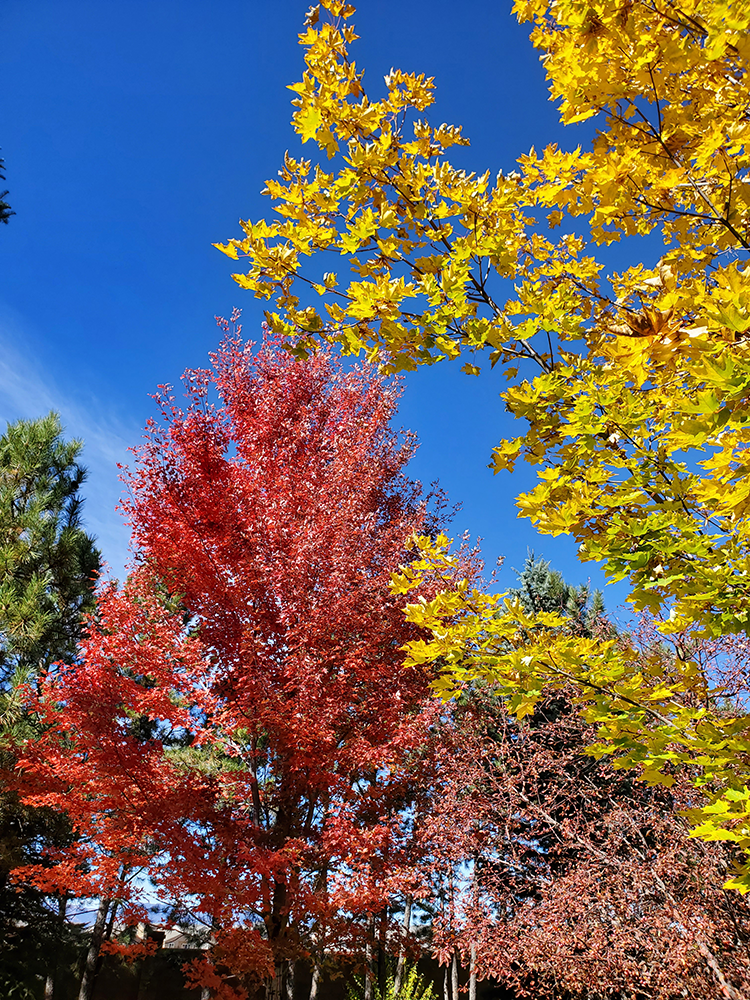

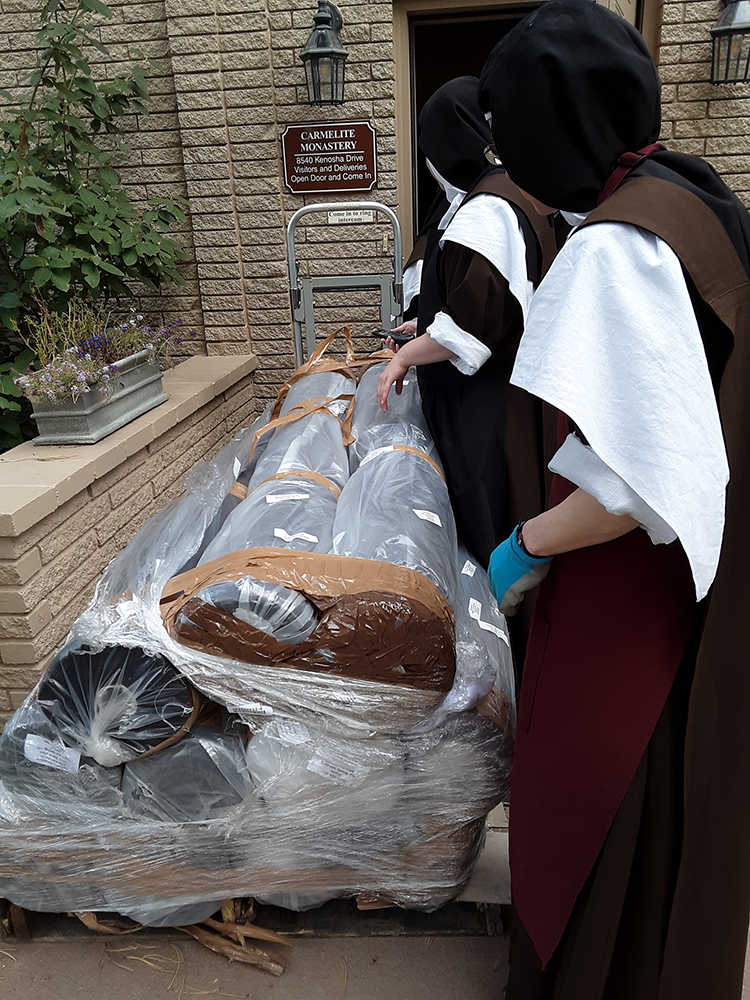
One good “problem” we faced is that we found ourselves running out of scapular brown wool! We consider this a good thing, since it means that Our Lady’s devotion is alive and well! A hospice nurse who has become a good friend of our Community regularly keeps a stock of scapulars (and relic badges) on hand to give to sick and dying patients who want one. Each time she writes us, it is with consoling stories of people being comforted in their final hours by the Scapular and who die wearing Our Lady’s garment of grace. Our long-trusted source in New York for 100% brown wool finally had a good amount in stock, having been unable to get it for some time. But since they were well-supplied, and we did not want to face any future “supply chain” issues or rising prices that might hinder our ability to make this important Sacramental – we bought out everything they had – and that would be 6 bolts of approximately 75 yards each. We will let you do the math! After all, we send out between 10,000 and 15,000 scapulars per year.
So one cold, drippy day in September, a large pallet wool, delivered by a huge freight truck, arrived at our front door. It took most of the Community – and a lot careful lifting – to move the hefty bolts inside and safely stack them in an upstairs storage room for future use. It seems we are now in good supply for a few years…

Christmas baking has begun. Yes, this early! Needless to say, so have the extra hours working to keep up with the website orders for Christmas cards and especially our handmade items, the rosaries, scapulars, and relic badges. Our recreations are very industriously spent, with each Sister having rosary pliers, needle, or crochet hook in hand!
All of these things are simply our daily duty before the good God. We take constant instruction and consolation from knowing that we fulfill God’s will and Our Blessed Mother’s direction to strive for perfection and to win souls through this moment-by-moment sacrifice each hour, each day, with love.
Know that you are part of our life in Carmel and in our prayers. Blessed Advent!
Your Carmelite Sisters
